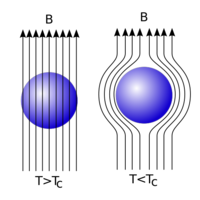Meissner effect: Difference between revisions
Ooshinowo3 (talk | contribs) No edit summary |
Ooshinowo3 (talk | contribs) No edit summary |
||
| Line 4: | Line 4: | ||
The Meissner effect is the expulsion of a magnetic field from a superconductor during its transition to the superconducting state, discovered by German physicists Walther Meissner and Robert Ochsenfeld in 1933. They discovered it by measuring the magnetic field outside superconducting tin and lead. | The Meissner effect is the expulsion of a magnetic field from a superconductor during its transition to the superconducting state, discovered by German physicists Walther Meissner and Robert Ochsenfeld in 1933. They discovered it by measuring the magnetic field outside superconducting tin and lead. | ||
[[File:Meissner effect1.png|200px|thumb|left|alt text]] | |||
Some materials tend to expel a magnetic field, materials that do this are called diamagnetic, but the effects of this diamagnetism are weak. For example, water and the human body are diamagnetic materials. | Some materials tend to expel a magnetic field, materials that do this are called diamagnetic, but the effects of this diamagnetism are weak. For example, water and the human body are diamagnetic materials. | ||
Revision as of 22:43, 30 November 2015
claimed by ooshinowo3
What is the Meissner Effect
The Meissner effect is the expulsion of a magnetic field from a superconductor during its transition to the superconducting state, discovered by German physicists Walther Meissner and Robert Ochsenfeld in 1933. They discovered it by measuring the magnetic field outside superconducting tin and lead.

Some materials tend to expel a magnetic field, materials that do this are called diamagnetic, but the effects of this diamagnetism are weak. For example, water and the human body are diamagnetic materials.
In superconducting material the Meissner effect creates currents which completely oppose the magnetic field applied by a magnet, in other words they will repel a magnet. This consequently makes a superconductor in the Meissner state a perfect diamagnet.
A Mathematical Model
What are the mathematical equations that allow us to model this topic. For example [math]\displaystyle{ {\frac{d\vec{p}}{dt}}_{system} = \vec{F}_{net} }[/math] where p is the momentum of the system and F is the net force from the surroundings.
A Computational Model
How do we visualize or predict using this topic. Consider embedding some vpython code here Teach hands-on with GlowScript
How does it Work?
A super conductor with little or no magnetic field within it is said to be in the Meissner state and breaks down when the magnetic field is too large A superconductor is fundamentally different from a conductor, because Faraday’s law of induction alone does not explain magnetic repulsion by a superconductor. At a temperature below its Critical Temperature, Tc, a superconductor will not allow any magnetic field to freely enter it. This is because microscopic magnetic dipoles are induced in the superconductor that oppose the applied field. This induced field then repels the source of the applied field, and will consequently repel the magnet associated with that field. This implies that if a magnet was placed on top of the superconductor when the superconductor was above its Critical Temperature, and then it was cooled down to below Tc, the superconductor would then exclude the magnetic field of the magnet. This means that a magnet already levitating above a superconductor does not demonstrate the Meissner effect, while a magnet that is initially stationary and then repelled by a superconductor as it is cooled through its critical temperature does.
Connectedness
- How is this topic connected to something that you are interested in?
- How is it connected to your major?
- Is there an interesting industrial application?
History
Put this idea in historical context. Give the reader the Who, What, When, Where, and Why.
See also
Are there related topics or categories in this wiki resource for the curious reader to explore? How does this topic fit into that context?
Further reading
Books, Articles or other print media on this topic
External links
Internet resources on this topic
References
This section contains the the references you used while writing this page